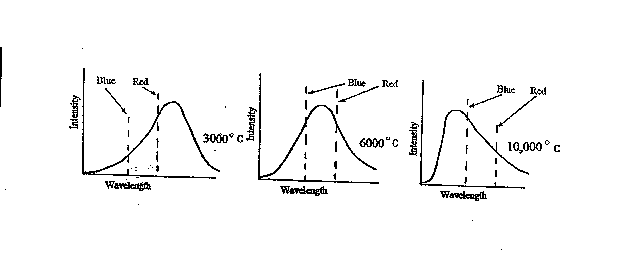 PREVIOUS PAGE
PREVIOUS PAGE
READ THE FOLLOWING PASSAGE CAREFULLY
If you look at the SKY at NIGHT you will see BRIGHT stars and DIM stars. The BRIGHTNESS of stars depends upon
(a) - How much POWER the star gives out and
(b) - How FAR away the star is from us.
A star that appears BRIGHT to us may be a dim star that is NEAR to us or a VERY bright star that is FAR away. To overcome this problem astronomers use the term TRUE BRIGHTNESS (or LUMINOSITY) to describe how bright a star is. This terms describes the POWER output of the star and is therefore INDEPENDENT of distance away from us.
The TRUE BRIGHTNESS of a star is often stated with reference to how much power our own SUN gives out (it has a power output = 1 SUN). For example, the NORTH POLE STAR (Polaris) which gives out 10,000 times the power of our own Sun is said to have a true brightness of 10,000 suns. The true brightness of stars varies enormously from about a million suns to one-millionth of a sun. Our own Sun is a very ORDINARY star!
If you look CAREFULLY at the stars at night you will notice that although most are WHITE. some look a little BLUISH and some slightly REDDISH in colour. This is because the WAVELENGTH of light given out by any object (including stars) depends upon its TEMPERATURE. A star with a temperature of:-
(a) 3,000 ºC looks slightly REDDISH
(b) 6,000 ºC looks WHITE
(c) 10,000 ºC looks BLUISH.

Answer the following questions on the BRIGHTNESS and TEMPERATURE of stars.
1 - Which of the following stars would appear brightest to someone looking at them from the Earth?
STAR A --- has a TRUE BRIGHTNESS of 2 suns and is 10 light years away
STAR B --- has a TRUE BRIGHTNESS of 2 suns and is 5 light years away
STAR C --- has a TRUE BRIGHTNESS of 1 sun and is 5 light years away
2 - When light passes through a PRISM it is split up into a number of different COLOURS (wavelengths).
a. What is this set of colours (which make up white light) called?
b. What are the different colours white light can be split up into?
c. Which colour has the SHORTEST wavelength?
3 - What colour would a star be if its surface temperature was 3,150 C?
The following two tables contain a RANDOM sample of stars; those which are CLOSEST to Earth and those which are BRIGHTEST in the sky.
THE NEAREST STARS
Name of Star Distance Away True Surface
from the Earth Brightness Temperature of
(light years) (Our Sun = 1) Star
Sun - 1.0 5,530
Proxima 4.2 0.1 2,530
Centauri
Alpha Centauri A 4.3 1.03 5,530
Alpha Centauri B 4.3 0.93 4,480
Barnard's Star 6.0 0.30 2,730
Wolf 359 7.7 0.01 2,430
BD 36 8.2 0.53 2,930
UV Ceti A 8.4 0.10 2,430
UV Ceti B 8.4 0.07 2,430
Sirius A 8.6 1.28 8,830
Sirius B 8.6 0.47 8,730
Ross 154 9.4 0.31 2,730
Ross 248 10.4 0.17 2,530
Eta Eri 10.8 0.89 4,330
Ross 128 10.9 0.28 2,630
Cygnus A 11.1 0.77 4,130
Cygnus B 11.1 0.70 3,930
Eta Ind 11.2 0.82 4,180
BD 43 A 11.2 0.53 3,030
BD 43 B 11.2 0.28 2,730
Procym A 11.4 1.2 6,330
Procym B 11.4 0.32 7,130
BD 59 A 11.6 0.47 2,830
BD 59 B 11.6 0.41 2,730
COD 11.7 0.60 3,030
N.B. (a) There are seven sets of BINARY stars in the above
table
(b) The BRIGHTNESSES are in fact log (true brightness)
1 - Plot a SCATTER graph of the TEMPERATURE of the star (on x-axis going up to about 27,000 C) against TRUE BRIGHTNESS (on y-axis going up to 2.0) Plot each star as a HEAVY dot. Also plot the stars on page 3.
a. All but EIGHT of the stars lie almost on a SMOOTH curve.
Draw a smooth
curve through MOST of the stars
b. Label on this curve our SUN; the HOT, BRIGHT stars
and the COOL, DIM
stars
SOME OF THE BRIGHTEST STARS
Name of Star Distance away True Brightness Surface
from the Earth Our Sun = 1) Temperature of
(light years) Star (C>
Canopus 74 1.61 7,330
Vega 25 1.35 9,630
Archernar 69 1.51 20,230
Betelgeuse 1,400 2.00 3,930
Hadar 320 1.77 25,230
Acrux 510 1.78 26,480
Altair 16 1.21 7,830
Aldebaran 60 1.43 3,860
Antares 520 1.83 3,010
Spica 220 1.67 25,230
Fomalhaut 22 1.23 8,780
Becrux 460 1.79 26,680
Deneb 1,500 2.00 9,070
Regulus 69 1.43 13,180
Adhara 570 1.80 22,730
Castor 49 1.36 9,380
Gacrux 120 1.50 2,730
Shaula 330 1.69 23,980
The stars lying on or near this curve are all about the same MASS and SIZE just like our Sun.
2 Look at the stars on the curve.
a. Explain the way in which it shows that stars' temperature
and true brightness are related
b. Where on the curve would you expect to find the
1. RED stars?
2. BLUE stars?
3 a. Label the two "WHITE DWARFS" on the curve
b. Write down the NAMES of the two "white dwarfs".
c. White dwarfs are SMALL stars (only about the size of the
Earth). Which THREE of the
following words describes a white dwarf?
Hot Dim Large Cool Bright Small
4 a. Label the six "RED GIANTS" on the curve.
b. Write down the names of the six "red giants".
c. Red giants are the LARGEST stars in the Universe (many
thousands of times the size of
our Sun). Which THREE of the following words describe
a red giant?
Hot Dim Large Cool Bright Small